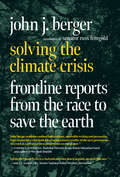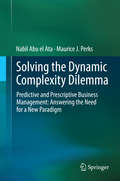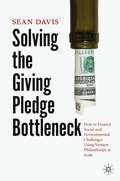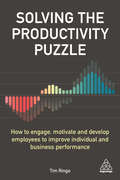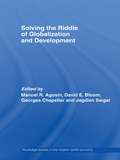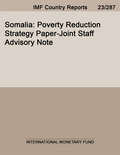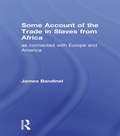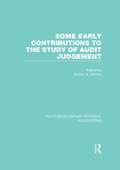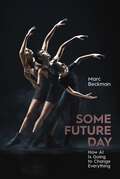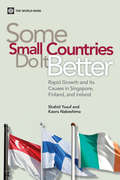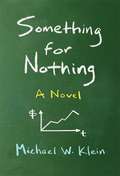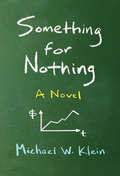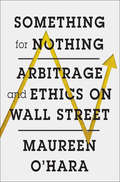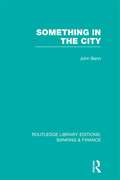- Table View
- List View
Solving the Climate Crisis: Frontline Reports from the Race to Save the Earth
by John J. BergerGroundbreaking solutions to the climate crisis from scientists, engineers, civic leaders, entrepreneurs and activists, offering hope to all readers concerned about our planet's future.Offers practical actions that reflect technological and economic advances with an introduction by former United States senator Russ Feingold.Solving the Climate Crisis is a hopeful and critical resource that makes a convincing and detailed case that there is a path forward to save our environment. Illustrating the power of committed individuals and the necessity for collaborative government and private-sector climate action, the book focuses on three essential areas:The technological dimension: move to 100% clean renewable energy as fast as we possibly can through innovations like clean-steel, &“green&” cement, and carbon-reuse companies;The ecological dimension: enhance and protect natural ecosystems, forests, and agricultural lands to safely store greenhouse gases and restore soils, transforming how we grow, process, and consume food;The social dimension: update and create new laws, policies and economic measures to recenter human values and reduce environmental and social injustice.Based on more than 6 years of research, Berger traveled the nation and abroad to interview governors, mayors, ranchers, scientists, engineers, business leaders, energy experts, and financiers as well as carbon farmers, solar and wind innovators, forest protectors, non-profit leaders, and activists.With real world examples, an explanation of cutting-edge technologies in solar and wind, and political organizing tactics, Solving the Climate Crisis provides a practical road map for how we effectively combat climate change. Replacing the fossil-fuel system with a newly invigorated, modernized, clean-energy economy will produce tens of millions of new jobs and save trillions of dollars. Protecting the climate is thus potentially the greatest economic opportunity of our time.
Solving the Dynamic Complexity Dilemma
by Nabil Abu el Ata Maurice J. PerksDynamic complexity results from hidden, unknown factors--or more precisely, interactions between factors--that can unexpectedly impact the performance of systems. When the influences of dynamic complexity are not measured and understood, new never-seen-before behaviors can come as unwelcomed surprises, which disrupt the performance of systems. Left alone, processes that were once prized for their efficiency unexpectedly begin to degrade--costs increase, while volumes and quality decline. Evidence of problems may come too late for effective resolution as technology advancements induce rapid change and compress the time available to react to that change. The results of dynamic complexity are always negative and unmanaged dynamic complexity can bring business or global systems to the point of sudden chaos. The 2009 H1N1 pandemic, 2008 Credit Crunch and 2011 Fukushima Daiichi nuclear disaster are global examples of the dangers of undiagnosed dynamic complexity. With increasing frequency executive leaders today are discovering that their business and IT system performance levels are not meeting expectations. In most cases these performance deficiencies are caused by dynamic complexity, which lies hidden like a cancer until the symptoms reveal themselves--often when it is too late to avoid negative impacts on business outcomes. This book examines the growing business problem of dynamic complexity and presents a path to a practical solution. To achieve better predictability, organizations must be able to expose new, dangerous patterns of behavior in time to take corrective actions and know which actions will yield the optimal results. The book authors promote new methods of risk management that use data collection, analytics, machine learning and automation processes to help organizations more accurately predict the future and take strategic actions to improve performance outcomes. The presented means of achieving this goal are based upon the authors' practical experiences, backed by scientific principles, and results achieved through consulting engagements with over 350 global organizations.
Solving the Giving Pledge Bottleneck: How to Finance Social and Environmental Challenges Using Venture Philanthropy at Scale
by Sean DavisThis book highlights the historic inflection point we are in, both in terms of philanthropy in general, and specifically in financing the solutions to our largest and most urgent social and environmental problems. It covers the two movements that have recently had a dramatic influence on capitalism. First, wealthy millennials have been pressuring their bankers to invest their family portfolios in companies with high social and environmental impact (ESG ratings), triggering a wave where the wealth management industry, and now all public companies, are significantly adapting to the increasing demand for good. Second, The Giving Pledge triggered another wave, changing what success and the accumulation of wealth means. It has even begun to redefine the goal of capitalism as more than 200 billionaires have pledged to give half or more of their wealth away. This book also focuses on the bottleneck problem that The Giving Pledge has created, as it is very hard to give hundreds of billions away with measurable impact to nonprofits lacking detailed long-term plans to scale. Nonprofits have never had the luxury of having all the resources to invest in the planning, management training and systems needed to rapidly expand. Thus taking in very large gifts is very difficult, and almost impossible to justify. Large philanthropy can always be used for traditional capital campaigns and to fund endowments, yet The Giving Pledge signers are often looking for large visible impact beyond these traditional avenues. The result is a bottleneck which has grown as more billionaires pledge their funds away while their wealth continues to skyrocket and giving rates stay very small. Finally, this book covers the emergence of large giving vehicles, modelled after the private equity industry. They have sophisticated third-party managers focused on deploying funds and supporting management teams. It also covers the scaling of nonprofits in a significant way (“Big Bets”) as well as investing large philanthropy through for-profits as Program Related Investments (PRI) at scale. This book is of interest specifically to nonprofit and foundation leaders, as well as wealth managers, estate attorneys and other philanthropic advisors. It is also of interest to investors and corporate CEOs as they begin to access these large pools for philanthropic capital to increase their impact. This book is focused on providing those with the ability to make large philanthropic investments a path to scale their impact and increase their fulfillment and that of their family. It provides a step-by-step guide of how these approaches, especially PRI at scale, can actually solve the social and environmental challenges that have been seemingly hopeless.
Solving the Giving Pledge Bottleneck: How to Finance Solutions Using Philanthropic Private Equity
by Sean DavisThis book highlights the historic inflection point we are in, both in terms of philanthropy in general, and specifically in financing the solutions to our largest and most urgent social and environmental problems. It covers the two movements that have recently had a dramatic influence on capitalism. First, wealthy millennials have been pressuring their bankers to invest their family portfolios in companies with high social and environmental impact (ESG ratings), triggering a wave where the wealth management industry, and now all public companies, are significantly adapting to the increasing demand for good. Second, The Giving Pledge triggered another wave, changing what success and the accumulation of wealth means. It has even begun to redefine the goal of capitalism as more than 230 billionaires have pledged to give half or more of their wealth away. This book also focuses on the bottleneck problem that The Giving Pledge has created, as it is very hard to give hundreds of billions away with measurable impact to nonprofits lacking detailed long-term plans to scale. Nonprofits have never had the luxury of having all the resources to invest in the planning, management training and systems needed to rapidly expand. Thus taking in very large gifts is very difficult, and almost impossible to justify. Large philanthropy can always be used for traditional capital campaigns and to fund endowments, yet The Giving Pledge signers are often looking for large visible impact beyond these traditional avenues. The result is a bottleneck which has grown as more billionaires pledge their funds away while their wealth continues to skyrocket and giving rates stay very small. Finally, this book covers the emergence of large giving vehicles, modelled after the private equity industry. They have sophisticated third-party managers focused on deploying funds and supporting management teams. It also covers the scaling of nonprofits in a significant way (“Big Bets”) as well as investing large philanthropy through for-profits as Philanthropic Private Equity. This book is of interest specifically to nonprofit and foundation leaders, as well as wealth managers, estate attorneys and other philanthropic advisors. It is also of interest to investors and corporate CEOs as they begin to access these large pools for philanthropic capital to increase their impact. This book is focused on providing those with the ability to make large philanthropic investments a path to scale their impact and increase their fulfillment and that of their family. It provides a step-by-step guide of how these approaches, especially Philanthropic Private Equity, can actually solve the social and environmental challenges that have been seemingly hopeless. The second edition also presents a plan to use these concepts to create a path to solve the housing crisis in America.
Solving the Productivity Puzzle: How to Engage, Motivate and Develop Employees to Improve Individual and Business Performance
by Tim RingoAn engaged and productive workforce is essential for organizational growth and business success. However, record levels of disengaged staff, a lack of motivation and employees feeling that they lack the necessary skills and support to excel at their jobs is putting this in jeopardy. HR practitioners are ideally placed to address these issues and boost productivity at every stage of the employee lifecycle to improve individual performance and drive business results. Solving the Productivity Puzzle is a practical guide for all people management professionals to address the challenge of stagnating people productivity. It covers how to embed learning and development activities to ensure that employees feel equipped with the skills they need to meet their goals, motivate a workforce made up of six generations with competing priorities, develop an effective workforce planning strategy to make sure the right people are in the right place at the right time, with the right motivation in the organization to build a company culture that allows people to thrive.Solving the Productivity Puzzle also includes expert guidance on how implement change to opportunity in the workforce, track and measure productivity and how to leverage new technologies to support employees. Including case studies from global organizations including Accenture, Aetna, Apple, Google, IBM, and SAP. This is essential reading for HR professionals needing to supercharge productivity in their organization for both employee and business success.
Solving the Riddle of Globalization and Development (Routledge Studies in the Modern World Economy)
by David E. Bloom Manuel R. Agosín Georges Chapelier Jagdish SaigalIn the past two decades many developing countries have embraced the challenge of globalization by rushing to dismantle trade barriers and to promote increasingly liberal market-oriented policies. However, a broader response to globalization is both necessary and possible if countries are to develop as quickly and as fully as possible. Exploring this complex interrelationship between globalization, liberalization, and human and social development, this innovative book undertakes a full analysis of development policy, strategy and practice in a variety of countries, with equal weight provided to Asia, Latin America and Africa. An internationally renowned team of contributors examines the complex network of connections and the implications for international development policy, strategy and practice. Advocating the inclusion of sustainable human development as a key element in countries' responses to globalization, key points highlighted include the need to nurture an enabling environment, and to promote education and R&D. These elements, coupled with sound macroeconomic management, are all required in equipping a country to integrate more effectively into the world economy. This innovative new approach to globalization and development set out in this volume will be essential reading for academics and practitioners alike.
Somalia: Poverty Reduction Strategy Paper-joint Staff Advisory Note (Imf Staff Country Reports)
by International Monetary Fund. Middle East and Central Asia Dept.A report from the International Monetary Fund.
Somalia: Poverty Reduction Strategy Paper-joint Staff Advisory Note (Imf Staff Country Reports)
by International Monetary Fund. Middle East and Central Asia Dept.A report from the International Monetary Fund.
Somatus: Value-Based Kidney Care (A)
by Robert S. Huckman Ariel D. Stern Sarah MehtaWhen Dr. Ikenna Okezie founded Somatus, a value-based kidney care provider, his goal had been nothing short of transforming kidney care delivery in the United States. Rather than relying on dialysis, a costly and intensive treatment for late-stage kidney disease, the Somatus model called for early identification of patients at high risk along with active management of the underlying conditions that accelerated kidney damage. But he had struggled to find health plans willing to take a chance on his unproven startup, especially in the highly concentrated dialysis treatment market. Thus, in 2017, Somatus agreed to manage traditional dialysis services for a group of hospitals in Virginia, focusing on improving the quality of care. In 2018, Somatus won its first contract with a health plan, finally allowing the startup to implement its full care model. But the contract generated just 10% of Somatus's revenues. Now, in December 2019, Okezie must decide whether to prioritize improving traditional dialysis services or continue to chase health plans willing to implement Somatus's innovative kidney care model.
Somatus: Value-Based Kidney Care (B)
by Robert S. Huckman Ariel D. Stern Sarah MehtaSet in early 2020, this (B) case provides an update to the (A) case (no. 622-009) and provides additional context regarding the challenges facing Somatus.
Some Account of the Trade in Slaves from Africa as Connected with Europe: On Connected With Europe And America
by James BandinelFirst published in 1842, this account has particular reference to the actions of the British Government.
Some Aspects of the Inequality of Incomes in Modern Communities
by Hugh DaltonDivided into four parts, the book is structured as follows:Part 1: Examines the extent to which the inequality of incomes is guided by ethical principles.Part 2: Illustrates the growth of the theory of distribution in the hands of successive generations of economists.Part 3: Develops the theory on the subject of the division of income between categories.Part 4: Looks at the division of income between people and the causes of that inequality, paying particular attention to the factor of inherited wealth.
Some Early Contributions to the Study of Audit Judgment (Routledge Library Editions: Accounting)
by Robert H. AshtonAlthough there has been increased emphasis on research that attempts to understand, evaluate and improve audit decision making in recent years it is less well-known that some noteworthy contributions to the study of audit judgment were made in the 1950s and 1960s. This anthology contains five such contributions which in the mid 1980s were previously unpublished, out of print or not widely appreciated. The volume discusses: the importance of studying audit judgment actual studies of audit judgment techniques for quantifying the evaluation of internal controls.
Some Fundamentals of Mathematics of Blockchain
by Julien RiposoThis book provides a foundation for the mathematics of blockchain. It is inspired by a general analysis and synthesis of the current knowledge of blockchain technology and starts by laying a foundation for the mathematics of blockchain. The aim is for research in the area of blockchain to lead their study from the construction highlighted in this book.First, the basis of a blockchain is set: block, transaction contents, block header, Merkle tree, nonce, Proof-of-Work. Connections with elliptic curves and cryptographic signatures are made.Second, the book ties this with a Graph and Matrix Theories approach and models the peer-to-peer relationship through the Bitcoin Network.Third, it is proposed further modelling, notably around halving, optimal storing, or diffusion of information, which are consequences of the mathematical foundation. The notion of Entropy of Privacy and the Particles model are introduced.Finally, the mathematical statements therein are proven and essential reminders can be found before each section, so the content can be accessible from a graduate level.
Some Future Day: How AI Is Going to Change Everything
by Marc BeckmanThis cutting-edge guide not only shows how AI is transforming our careers, lives, businesses, and more, but also provides easy, actionable steps to make AI work for us. In this groundbreaking book, celebrated professor, entrepreneur, author, and podcaster Marc Beckman explores the transformative power of artificial intelligence (AI) and how it&’s poised to enhance and transform all aspects of society—revolutionizing our careers, enriching our family lives, and bringing our communities closer together. From business and advertising, to medicine, to warfare, to politics—Beckman meticulously explores the different areas where we&’ll soon feel AI&’s transformative impact. But that&’s only half of it. Throughout this book, he also provides the specific steps readers can take now to make sure these coming changes work for them. From the workplace to the home, AI is poised to reshape the way we approach our professional and personal lives. Beckman uses this book to make the case that AI will free up valuable time and energy, allowing individuals to focus on more creative and meaningful work, but also that AI will create possibilities for engagement that were unthinkable just a generation ago. He shows that with AI as our co-pilot, we&’ll unlock new opportunities for growth, innovation, and collaboration—all of which will lead to more fulfilling and rewarding careers. Beckman illustrates how AI will strengthen family bonds and improve the quality of our home lives too, changing everything from how we educate our kids to how we stay connected on social media. And as AI becomes more integrated into our cities and towns, it will play a crucial role in fostering a sense of community and belonging; through AI-powered platforms, Beckman shows how we will collaborate on projects, share resources, and support one another in times of need. This thought-provoking and essential book is a definitive guide to the many ways in which AI will transform our lives for the better . . . but also surprise us, delight us, force us to (re)consider how we interact with one another, and make us question what exactly counts as &“human.&” Join Marc Beckman on this exciting journey as he explores the near-endless possibilities of a world powered and transformed by artificial intelligence. It&’s an Age of Imagination . . . where the only limit is your own mind.
Some Small Countries Do It Better
by Shahid Yusuf Kaoru NabeshimaCountries worldwide are struggling to imitate the industrial prowess of the East Asian pacesetters, but growth accelerations have proven remarkably transient. Building a portfolio of tradable goods and services and steadily raising the level of investment in these activities, has generally defied the best policy efforts – in particular, bringing investment ratios on par with East Asian averages has presented the greatest challenge. Hence the search is on for growth recipes not so tightly bound to investment, to manufacturing activities, and to the export of manufactured products. In casting around for such recipes validated by demonstrated results, the experience of economies which have relied more on other drivers of growth – human capital and knowledge – is highly attractive. Finland and Ireland are among the tiny band of small nations that grew rapidly for well over a decade by achieving the maximum mileage from an adequate investment in physical assets and by harnessing the potential of human capital and technologies. Singapore combined high investment with a comprehensive and complementary strategy of building high quality human and knowledge assets. This approach enabled the three countries to diversify much faster into higher tech manufactures and tradable services and profit from globalization. The approach adopted by these three countries may be of greater relevance in the highly competitive global environment of the early 21st century because it does not necessarily assume heroic levels of investment. Moreover, it may be better tailored to the opportunities for middle and lower middle income economies threatened by the middle income trap and seeking growth rates in the 6 percent range, and for the smaller, late starting, low income countries with youthful, rapidly increasing populations that need to grow at high single digit rates in order to create enough jobs and to double per capita incomes in 10 years.
Some Thoughts on Business Plans
by William A. SahlmanA framework for assessing new business opportunities and the business plans used to describe them is developed. Useful for aspiring entrepreneurs in MBA programs.
Some Uncomfortable Arithmetic Regarding Europe's Public Finances
by Delia VelculescuA report from the International Monetary Fund.
Somebody Else’s Problem: Consumerism, Sustainability and Design
by Robert CrockerGold winner of the AXIOM Business Book Award in the category of Philanthropy, Non-Profit, Sustainability. Please see: http://www.axiomawards.com/77/award-winners/2017-winners Consumerism promises a shortcut to a 'better' life through the accumulation of certain fashionable goods and experiences. Over recent decades, this has resulted in a rising tide of cheap, short-lived goods produced, used and discarded in increasingly rapid cycles, along the way depleting resources and degrading environmental systems.Somebody Else’s Problem calls for a radical change in how we think about our material world, and how we design, make and use the products and services we need. Rejecting the idea that individuals alone are responsible for the environmental problems we face, it challenges us to look again at the systems, norms and values we take for granted in daily life, and their cumulative role in our environmental crisis.Robert Crocker presents an overview of the main forces giving rise to modern consumerism, looks closely at today’s accelerating consumption patterns and asks why older, more ‘custodial’ patterns of consumption are in decline. Avoiding simplistic quick-fix formulas, the book explores recommendations for new ways of designing, making and using goods and services that can reduce our excess consumption, but still contribute to a good and meaningful life.
Somebody in Charge: A Solution to Recessions?
by Pierre LemieuxCould the financial crisis have been prevented with better leadership? This book explores answers to this question from a scholarly and academic economic viewpoint.
Someday Rich
by Matt Smith Timothy NoonanTo truly be successful, today's financial advisor must strike the right balance between effectively engaging with his or her clients and finding meaningful ways to maintain their financial security. By framing your mission in this way, you can help your clients clarify their vision, build a plan to achieve it, and manage that plan so they stay on track.Nobody understands this better than authors Timothy Noonan and Matt Smith--two seasoned financial professionals with over five decades of combined experience working in the asset management business. And now, in Someday Rich, they show financial advisors with clients who are rich, or have the opportunity to become rich, how to sustain a client's desired lifestyle to, and through, retirement.Engaging and informative, Someday Rich provides the context, description, and implementation suggestions for the Personal Asset Liability Model--a process that will allow you to determine a client's funded status relative to their future spending needs as well as develop and monitor their investment plan accordingly. While the methods in the Personal Asset Liability Model may not have been practically accessible to past advisors with a large number of clients, this model now brings together the technical methods to answer important client questions in a way that is feasible and includes the communication strategies that can make the delivery of the advice model more effective.Along the way, this reliable resource discusses the business of giving good advice and addresses how to incorporate these steps into a client engagement road map. Insights on various other issues associated with this discipline are also included, such as how to develop client trust and deliver personalized service when you have so many clients, and contingency risks--life, health, disability, and long-term care--that need to be considered in the financial planning process. And in later chapters, single-topic essays, contributed by experts in the financial planning field, cover issues ranging from target date funds and the investment aspects of longevity risk to modern portfolio decumulation.Building more valuable relationships with your clients is a difficult endeavor. But with Someday Rich, you'll discover what it takes to achieve this goal as you put them on a path to a sustainable financial future.
Something for Nothing
by Michael W. KleinDavid Fox (Ph. D. Economics, Columbia, Visiting Assistant Professor at Kester College, Knittersville, New York) is having a stressful year. He has a temporary position at a small college in a small town miles from everything except Albany. His students have never read Freakonomics. He thinks he is getting the hang of teaching, but a smart and beautiful young woman in his Economics of Social Issues class is distractingly flirtatious. His research is stagnant, to put it kindly. His search for a tenure-track job looms dauntingly. (The previous visiting assistant professor of economics is now working in a bookstore. ) So when a right-wing think tank called the Center to Research Opportunities for a Spiritual Society (CROSS)--affiliated with the Salvation Academy for Value Economics (SAVE)--wants to publish (and publicize) a paper he wrote as a graduate student showing the benefits of high school abstinence programs, fetchingly retitled "Something for Nothing," he ignores his misgivings and accepts happily. After all, publication is "the coin of the realm," as a senior colleague puts it. But David faces a professional and moral dilemma when he finds that his prized results may just be the consequence of a programming error. The school year is filled with other challenges as well, including faculty politics, a romance with a Knittersville native, running the annual interview gauntlet, and delivering the culminating "job talk" lecture under trying circumstances. David's adventures offer an instructive fictional guide for the young economist and an entertaining and comic tale for everyone interested in questions of balancing career and life, success and integrity, and loyalty and desire.
Something for Nothing: A Novel
by Michael W. KleinA young economic professor's adventures in his quest for a tenure-track position and a well-balanced life. David Fox (Ph.D. Economics, Columbia, Visiting Assistant Professor at Kester College, Knittersville, New York) is having a stressful year. He has a temporary position at a small college in a small town miles from everything except Albany. His students have never read Freakonomics. He thinks he is getting the hang of teaching, but a smart and beautiful young woman in his Economics of Social Issues class is distractingly flirtatious. His research is stagnant, to put it kindly. His search for a tenure-track job looms dauntingly. (The previous visiting assistant professor of economics is now working in a bookstore.) So when a right-wing think tank called the Center to Research Opportunities for a Spiritual Society (CROSS)—affiliated with the Salvation Academy for Value Economics (SAVE)—wants to publish (and publicize) a paper he wrote as a graduate student showing the benefits of high school abstinence programs, fetchingly retitled “Something for Nothing,” he ignores his misgivings and accepts happily. After all, publication is “the coin of the realm,” as a senior colleague puts it. But David faces a personal dilemma when his prized results are cast into doubt. The school year is filled with other challenges as well, including faculty politics, a romance with a Knittersville native, running the annual interview gauntlet, and delivering the culminating “job talk” lecture under trying circumstances. David's adventures offer an instructive fictional guide for the young economist and an entertaining and comic tale for everyone interested in questions of balancing career and life, success and integrity, and loyalty and desire.
Something for Nothing: Arbitrage and Ethics on Wall Street
by Maureen O'HaraFrom a leading financial economist, a searching examination of the ethics of modern finance. In 2001, Goldman Sachs structured a complex financial contract so that its client, the government of Greece, would appear to have far less debt than it actually did. When news of this transaction came out years later, the inevitable question arose: Even though Goldman's actions were legal, were they ethically wrong? Is modern finance itself inherently unethical? In Something for Nothing, financial economist Maureen O'Hara explains that one of the key innovations of modern finance is its reliance on arbitrage, the practice of taking advantage of a price difference between two or more markets to generate profits and remove inefficiencies. When done correctly, arbitrage can create value at little or no cost (in effect, getting "something for nothing"); but it can also be an exploitative tool. In a lucid, insightful discussion of the ethics of arbitrage in modern finance, O'Hara reveals how the rules can often be stretched into still-legal yet highly unethical business practices. Examining key cases in clear and persuasive prose, O'Hara illuminates various aspects of financial ethics, from the Goldman Greek transaction to Lehman Brothers' attempt to cover up its debt, JPMorgan Chase's maneuvers in California's energy markets, Bernie Madoff's trading strategies in the 1980s, high-frequency trading practices, and toxic loans in France. Ultimately, O'Hara turns to philosophy and religion to argue for a new, humanistic approach to ethics in the financial industry. She makes a strong case for a way forward: fewer rules and more standards to foster a morally responsible outlook. Fearlessly raising the questions at the moral heart of our financial system, Something for Nothing is a masterful treatise on the ethics of modern finance.
Something in the City (Routledge Library Editions: Banking & Finance)
by John BennPrompted by the widespread curiosity aroused by the proceedings of the Parker Bank Rate Tribunal, the author has written a non-technical account of daily life in a City office and Boardroom. The author describes the ways in which money is put to work, and explains why the Sterling Area is so important to Britain’s prosperity. He also discusses political developments affecting the City and its future. The book includes references to America and Wall Street.
